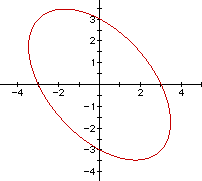
Consider the graph of the circle
![]()

The circle could be considered a special case of the equation
![]()
with n equal to zero. In fact we can generate special cases of ellipses, hyperbolas, and even parallel lines in one case, by using this equation.
After a bit of investigation using various values of n, we find that when 0 < n < 2 and 0 > n> -2 , the graph of
![]()
is always an ellipse whose major axis the the line y = - x. For example let n = 1, then
![]()
has the following graph

You can even change the orientation of the ellipse by changing n.
Suppose n = -1 , then we have the equation
![]()

So what happens when -2 < n > 2 , then the graph is always a hyperbola.
If n > 2 , then the hyperbola is symmetric with the lines y = x and y = -x.
For example let n =3
![]()
has the following graph

And as with the ellipse, you can change the orientation of the hyperbola by changing n. If n < -2 then the hyperbola is still symmetric with respect to the lines y = x and y = - x but graph does not intersect the line y = x.
Suppose n = -3 , then we have the equation
![]()

Interestingly enough one can generate parallel lines given the equation
![]()
You guessed it, if n = 2 , then the graph of the equation
![]()
is a system of parallel lines.

But you might have guessed this already since if
![]()
then we have a perfect square trinomial,
![]()
hence,
x + y = 3 and x + y = -3.
Similarly, if n = -2, lines are generated.
![]()

So in looking at the graphs generated by the equation
![]()
what are the commonalities? Upon inspection of the graphs generated for each of the following cases
Case 1: n = 0
Case 2: -2 < n < 0 and 0 < n < 2
Case 3: -2 < n > 2
Case 4: n = 2 and n = -2
it can be seen that the x-intercepts for the graphs are -3, 3 and the y-intercepts are -3 and 3.
We can also see by inspection that y = x and y = - x are lines of symmetry for the graphs of the equations generated for each of the cases deliniated above.
The family of equations generated by
![]()
is extremely useful in connecting the information learned about lines to second degree equations.
Consider building a family of second degree equations from the linear equations x + y = 3, x - y = 3.
Have the students find all the possible equations generated by these three lines.
Case 1: (x+y)(x+y) = 9

Case 2: (x+y)(x- y) = 9

Case 3: (x- y)(x- y) = 9

Now what happens if you change the coefficients of x and y for the lines x+y =3 and x+y = -3? Can you ever get an ellipse?